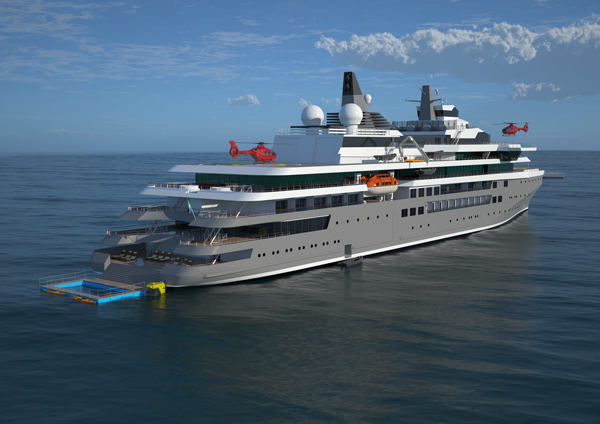
Damen presents design for expedition cruise vessel

Artist’s impression of the expedition cruise vessel (Source: Damen)
With Damen taking the lead, the design also draws on the expertise of Expedition Voyage Consultants Ltd (EVC), based on the Isle of Man, and the Danish naval architecture firm Knud E. Hansen.
Damen notes that EVC's wealth of practical expedition experience – it has led well over 500 expeditions – was instrumental in creating a fit-for-purpose vessel with safe and efficient operations embedded into its design. As for Knud E. Hansen, its more than 700 cruise vessel designs include that of the first-ever expedition cruise ship, Damen adds.
The Damen expedition cruise vessel has been designed for expeditions in both remote polar and tropical regions.
“The vessel’s Polar Class 6 compliance and 30-day autonomous cruising capability ensure it’s globally capable and able to tackle challenging, far-reaching itineraries,” said Henk Grunstra, Damen's product director. “Furthermore, the vessel’s design is prepared to comply with SOLAS Safe Return to Port requirements.”
A core philosophy of the design was to connect the passengers to the pristine environments in which the vessel will sail, Damen says. Whether sailing by Pacific atolls or Antarctic icebergs, passengers will take in the views on multiple viewing platforms that extend over the side or past the bow, providing the most spectacular vantage point of any expedition ship, according to the shipbuilder. Perched on the ship’s mast, a specially developed crow’s nest will aid visibility during ice navigation as well as give passengers a panoramic view.
With approximately 1,100m2 of public space and 2,500m2 of outside deck, there will be sufficient space for 115 passengers, and a +200 pax design will be developed soon.
For the propulsion system, Damen has selected a diesel-mechanical hybrid configuration with IMO Tier III-compliant (EPA Tier 4-equivalent) medium-speed engines. A PTI-PTO variable frequency drive will also be included, enabling efficient load distribution on the engines.
Designed to be "battery-ready", the vessel could be equipped with an energy-storage battery system capable of various functions such as peak-shaving, provision of supplementary power for manoeuvring or silent sailing operations and auxiliary generator UPS.
“This hybrid propulsion technology is the most fuel-efficient option available,” remarked Grunstra, referring to the vessel’s 16-knot service speed and 18-knot maximum speed. “In combination with the hull design and the effective use of electricity on board, we're expecting to reach fuel consumption and CO2 reductions of at least 20%.”
